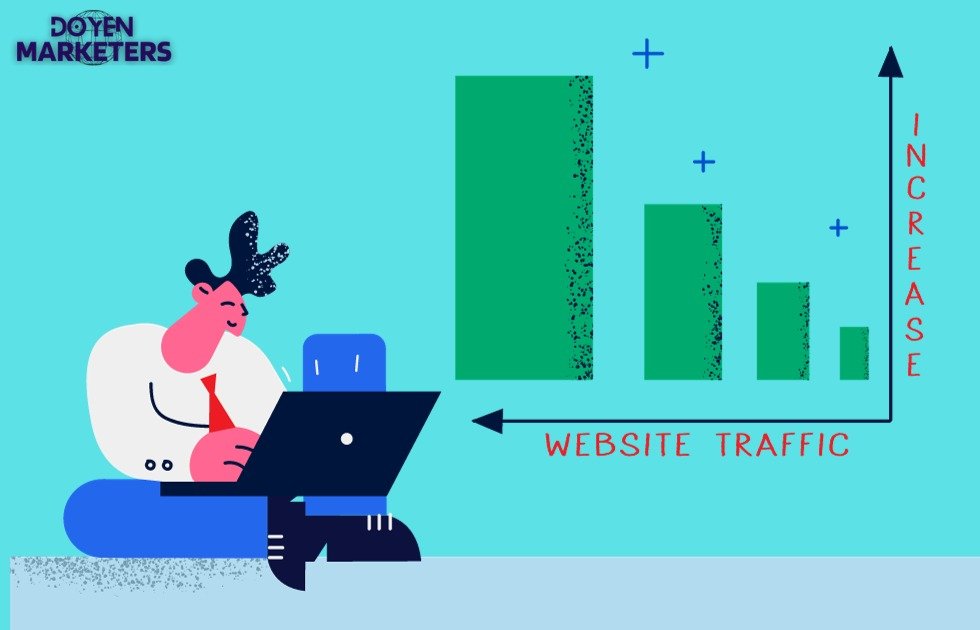If you’re running a website, you know that traffic is the lifeblood of your online presence. Without visitors, your site will be nothing more than a digital ghost town. That’s why content marketing is such a powerful tool for increasing website traffic. By creating valuable, engaging content, you can attract new visitors and keep them coming back for more.
But what exactly is content marketing? At its core, content marketing is all about creating and sharing content that’s designed to attract and engage your target audience. This can take many different forms, from blog posts and infographics to videos and podcasts. The key is to create content that’s valuable and relevant to your audience and to distribute it through the channels where they’re most likely to see it.
So, how can you use content marketing to increase website traffic? There are a few key strategies to keep in mind. First, you need to create engaging content that’s designed to capture your audience’s attention and keep them coming back for more. This means focusing on topics that are relevant to your audience and using a variety of formats to keep things interesting.
You also need to leverage social media and email marketing to promote your content and drive traffic to your site. Finally, you need to analyze your performance and adjust your strategy as needed to ensure that you’re getting the best possible results.
Key Takeaways
Table of Contents
- Content marketing is all about creating and sharing valuable content to attract and engage your target audience.
- To increase website traffic with content marketing, you need to create engaging content, leverage social media and email marketing, and analyze your performance.
- By following these strategies, you can attract more visitors to your site and keep them coming back for more.
Understanding Content Marketing
As a website owner, you want to attract as many visitors as possible. One of the most effective ways to do this is through content marketing. In this section, we will take a closer look at what content marketing is and how it can help you increase your website traffic.
Importance of Content Marketing
Content marketing is a type of digital marketing that involves creating and sharing valuable content to attract and retain a target audience. The goal of content marketing is to build trust and credibility with your audience, which can lead to increased engagement, loyalty, and, ultimately, conversions.
One of the most significant advantages of content marketing is that it is a long-term strategy. Unlike paid advertising, which stops working as soon as you stop paying for it, content marketing can continue to drive traffic to your website for months or even years after it has been published. This is because high-quality content is more likely to be shared and linked to by other websites, which can help improve your search engine rankings and drive more traffic to your site.
Content Marketing vs SEM
While content marketing and search engine marketing (SEM) are both essential components of a digital marketing strategy, they are not the same thing. SEM involves using paid advertising to drive traffic to your website, while content marketing focuses on creating valuable content to attract organic traffic.
One of the main advantages of content marketing over SEM is that it is often more cost-effective. While SEM can be effective for driving traffic in the short term, it can also be expensive, especially if you are targeting competitive keywords. Content marketing, on the other hand, involves creating high-quality content that can continue to drive traffic to your website for months or even years after it has been published.
In summary, content marketing is an effective way to attract and retain a target audience, build trust and credibility, and drive long-term traffic to your website. By creating high-quality content that provides value to your audience, you can improve your search engine rankings, increase engagement, and, ultimately, drive more conversions.
Increasing Website Traffic
To increase website traffic with content marketing, you need to focus on three main areas: search engine optimization (SEO), keywords, and building backlinks.
Role of SEO
SEO plays a critical role in driving organic traffic to your website. By optimizing your website for search engines, you can improve your search rankings and attract more visitors to your site. To get started with SEO, you should:
- Use relevant keywords in your content.
- Optimize your website’s meta tags.
- Use descriptive URLs
- Create high-quality, long-form content.
- Use header tags to structure your content.
- Optimize your images and videos.
Importance of Keywords
Keywords are the foundation of SEO. By using relevant keywords in your content, you can improve your search rankings and attract more visitors to your site. To find the right keywords for your content, you can use tools like Keywords Everywhere and Google Search Console. When selecting keywords, focus on long-tail keywords that are relevant to your audience and have a low level of competition.
Building Backlinks
Building backlinks is another important aspect of content marketing. Backlinks are inbound links from other websites to your site. They signal to search engines that your website is a reputable source of information. To build backlinks, you can:
- Guest posts on other websites
- Reach out to other websites for link exchanges.
- Create high-quality, shareable content that other websites will want to link to
By focusing on SEO, keywords, and building backlinks, you can increase your website traffic and attract more visitors to your site.

Creating Engaging Content
To increase website traffic with content marketing, you need to create engaging content that resonates with your audience. Engaging content is content that captures the attention of your audience and encourages them to take action, whether it’s to read more, share with others, or make a purchase.
Types of Content
There are many types of content that you can create to engage your audience, such as blog posts, videos, podcasts, infographics, and visuals. Each type of content has its strengths and weaknesses, and you should choose the type of content that works best for your audience and your goals.
Quality over Quantity
When it comes to content marketing, quality is more important than quantity. Creating high-quality content that provides value to your audience is more effective than creating a large volume of low-quality content. Focus on creating content that is informative, entertaining, and helpful to your audience.
Evergreen Content
Evergreen content is content that remains relevant and useful over time. It’s the type of content that people will continue to search for and read long after it’s been published. Creating evergreen content is a great way to increase website traffic and establish yourself as an authority in your industry. Examples of evergreen content include educational content, tutorials, and whitepapers.
By creating engaging content that provides value to your audience, you can increase website traffic and achieve your content marketing goals. Consider using Facebook ads or other promotional tactics to get your content in front of a wider audience. Remember, the key to success in content marketing is to create high-quality, evergreen content that resonates with your audience.
Leveraging Social Media
One of the most effective ways to increase website traffic through content marketing is by leveraging social media. Social media platforms like Facebook, Instagram, and Twitter can help you reach a wider audience and increase engagement with your brand.
Promoting on Facebook
Facebook is one of the most popular social media platforms, and it can be an excellent tool for promoting your website content. Here are some tips for using Facebook to drive traffic to your site:
- Create engaging social media posts that include a link to your website content
- Use Facebook Ads to target specific audiences and drive traffic to your site
- Join Facebook Groups related to your niche and share your content with the group
Using Instagram
Instagram is a visual platform that can be used to showcase your website content and increase engagement with your audience. Here are some tips for using Instagram to drive traffic to your site:
- Create visually appealing posts that include a link to your website content in your bio
- Use Instagram Stories to promote your website content and engage with your audience
- Partner with influencers in your niche to reach a wider audience and drive traffic to your site
Twitter Marketing
Twitter is a fast-paced platform that can be used to promote your website content and engage with your audience in real time. Here are some tips for using Twitter to drive traffic to your site:
- Tweet links to your website content with relevant hashtags to reach a wider audience
- Use Twitter Ads to target specific audiences and drive traffic to your site
- Engage with your audience by responding to tweets and participating in Twitter chats related to your niche
By leveraging social media, you can increase engagement with your audience and drive more traffic to your website. Use these tips to create a social media strategy that works for your brand and helps you achieve your content marketing goals.

Email Marketing
Email marketing is a powerful tool for increasing website traffic through content marketing. By building an email list, you can reach out to potential customers and keep them informed about your latest content. In this section, we will discuss how to build an email list and create effective email campaigns.
Building Email List
The first step in email marketing is to build an email list. There are several ways to do this, including:
- Offering a free download or resource in exchange for email addresses
- Adding a sign-up form to your website or blog
- Hosting a giveaway or contest that requires email sign-up
It’s essential to ensure that your email list consists of leads who are genuinely interested in your content. Purchasing email lists or using unethical tactics to collect email addresses can result in low engagement rates and damage your reputation.
Email Campaigns
Once you have built an email list, it’s time to create effective email campaigns. Here are some tips for creating successful email campaigns:
- Personalize your emails with the recipient’s name and relevant content
- Use attention-grabbing subject lines to encourage recipients to open your emails
- Include clear calls-to-action that encourage recipients to visit your website
- Segment your email list based on interests or behaviors to send targeted content
It’s important to remember that email marketing is not a one-time event. Regularly sending engaging emails can keep your brand top-of-mind and encourage recipients to visit your website regularly.
In conclusion, email marketing is a powerful tool for increasing website traffic through content marketing. By building an email list and creating effective email campaigns, you can reach out to potential customers and keep them engaged with your brand.
Analyzing Performance
To determine the effectiveness of your content marketing strategy, you need to analyze its performance. Here are some ways to measure your success:
Using Google Analytics
Google Analytics is a powerful tool that can help you track your website’s traffic and user behavior. You can use it to identify which pages are getting the most traffic, which keywords are driving visitors to your site, and how long people are staying on your pages.
You can also use Google Analytics to track your conversion rates and ROI. By setting up goals and tracking your progress, you can see which pages are driving the most leads and sales.
Understanding SERP
Search Engine Results Pages (SERP) are the pages that appear when someone types a query into a search engine. By understanding how your website ranks on SERP, you can optimize your content to improve your visibility and attract more traffic.
You can use tools like SEMrush and Ahrefs to track your website’s ranking for specific keywords. By analyzing your competitors’ rankings, you can identify gaps in your content and target those keywords to improve your visibility.
Bounce Rate
Bounce rate is the percentage of visitors who leave your website after viewing only one page. A high bounce rate can indicate that your content is not engaging or relevant to your target audience.
To reduce your bounce rate, you can improve your website’s design and navigation, create more engaging content, and optimize your keywords and meta descriptions.
By analyzing your website’s performance using these metrics, you can identify areas for improvement and optimize your content marketing strategy to attract more leads and drive more sales.
Influencer Marketing
One of the most effective ways to increase website traffic through content marketing is through influencer marketing. Influencers are individuals who have a significant online following and are considered experts or thought leaders in their respective industries. By collaborating with influencers, you can tap into their audience and gain exposure to a wider range of potential customers.
Collaborating with Influencers
When collaborating with influencers, it is essential to choose individuals who align with your brand and target audience. This will ensure that the content they create resonates with their followers and drives traffic to your website. Here are some tips for collaborating with influencers:
- Research potential influencers: Look for individuals who have a significant following in your industry and whose values align with your brand.
- Reach out to influencers: Once you have identified potential influencers, reach out to them with a personalized message explaining why you think they would be a good fit for your brand and what you hope to achieve through the collaboration.
- Set clear goals: Before starting the collaboration, set clear goals for what you hope to achieve, such as increased website traffic or social media engagement.
- Provide value: To ensure that the collaboration is mutually beneficial, provide value to the influencer by offering exposure to your audience or compensating them for their time and effort.

Guest Posts
Another way to leverage influencer marketing is through guest posts. Guest posts are articles or blog posts written by influencers that are published on your website. This can drive traffic to your website and increase your authority in your industry. Here are some tips for guest post collaborations:
- Identify potential guest bloggers: Look for influencers who have a strong online presence and whose expertise aligns with your brand.
- Reach out to potential guest bloggers: Once you have identified potential guest bloggers, reach out to them with a personalized message explaining why you think they would be a good fit for your brand and what you hope to achieve through the collaboration.
- Set guidelines: To ensure that the guest post aligns with your brand and provides value to your audience, set clear guidelines for the content and format of the post.
- Include an author bio: To help drive traffic to your website, include an author bio at the end of the guest post that includes a link back to your website.
By leveraging the power of influencers, you can increase your website traffic and establish yourself as an authority in your industry.
Content Planning
If you want to increase website traffic through content marketing, content planning is an essential step that you cannot skip. Content planning involves creating a content strategy, developing a content calendar, and creating an editorial calendar.
Creating a Content Calendar
A content calendar is a schedule that shows when you will publish your content. It provides a snapshot of the content you plan to publish over a specific period. Creating a content calendar helps you to organize your content and ensure that you publish consistently.
When creating a content calendar, you need to consider the following:
- Your target audience: Who is your target audience, and what type of content do they prefer?
- Your marketing goals: What are your marketing goals, and how can your content help you achieve them?
- Your content format: What type of content will you publish, such as blog posts, videos, infographics, or podcasts?
- Your publishing frequency: How often will you publish your content? Daily, weekly, or monthly?
- Your publishing channels: Where will you publish your content? On your website, social media, or other platforms?
Editorial Calendar
An editorial calendar is a more detailed version of your content calendar. It outlines the specific topics, keywords, and content formats you will use for each piece of content. It also includes deadlines for research, writing, editing, and publishing.
When creating an editorial calendar, you need to consider the following:
- Your content themes: What topics will your content cover, and how will they tie into your marketing goals?
- Your keyword research: What keywords will you target, and how will you use them in your content?
- Your content formats: What type of content will you create, and how will you optimize it for search engines and social media?
- Your publication schedule: When will you publish each piece of content, and how will you promote it?
- Your team roles: Who will be responsible for researching, writing, editing, and publishing each piece of content?
By creating a content calendar and editorial calendar, you can ensure that you publish high-quality content consistently. This will help you to attract more traffic to your website and build a loyal audience.
Conclusion
In conclusion, content marketing is a powerful tool to increase website traffic. By creating high-quality content that is valuable to your target audience, you can attract more visitors to your site, build your brand, and establish yourself as an authority in your industry.
To maximize the impact of your content marketing efforts, it’s important to focus on creating content that is both informative and engaging. This means using a variety of formats, such as blog posts, videos, infographics, and social media updates, to reach your audience where they are.
In addition, you should always be measuring the results of your content marketing efforts to ensure that you are on track to meet your goals. This means tracking metrics such as website traffic, engagement rates, and conversions and making adjustments to your strategy as needed.
Overall, content marketing is a long-term strategy that requires patience, persistence, and a willingness to experiment and adapt. By following the best practices outlined in this guide, you can create a content marketing strategy that drives traffic, builds your brand, and delivers results for your business. Visit Doyen Marketers Again for more informative content.















